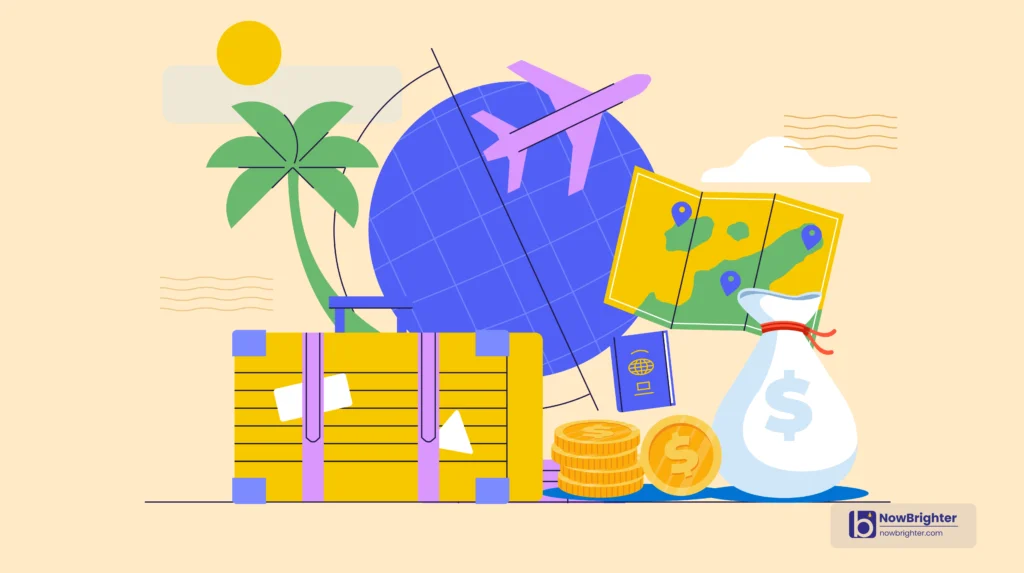8 Tip to Budget for Travel: Saving for Your Next Adventure
Dreaming of your next adventure but worried about the cost? Travel doesn’t have to drain your savings if you plan wisely. Learning how to budget for travel can turn that dream getaway into a reality without financial stress. Whether you’re saving for a weekend escape or a month-long journey, these 8 proven tips will help you set aside funds, manage expenses, and still enjoy the trip of a lifetime. Ready to start saving for your next adventure? Let’s dive in!
In this article, we’ll share eight expert tips on how to budget for travel effectively, so you can turn your dream trip into a reality. Whether you want to backpack through Europe, relax on a tropical beach, or explore bustling cities, these tips will help you save and make the most of every dollar.

Tip1. Set a Clear Travel Goal
One of the most important steps in budgeting for travel is setting a clear travel goal. Without a specific goal, your savings efforts can become unfocused, and it’s easy to lose motivation.
Start by deciding exactly where you want to go and what type of trip you want to take. Are you planning a luxury vacation at a five-star resort, or do you prefer budget-friendly backpacking through multiple countries? Knowing your destination and travel style will help you estimate how much money you need to save. This is the foundation of your travel budget.
Research Costs
Next, research the estimated costs for the key components of your trip: airfare, accommodation, food, activities, and transportation. Use websites like Google Flights, Skyscanner, or Airbnb to get a general sense of the pricing. If you want to get even more precise, look up local blogs or travel forums to get insights from people who have already visited your destination.
Once you have these estimates, add a 10-20% buffer for unexpected expenses. After all, things like emergency purchases, extra meals, or surprise activity costs can pop up at any time.
Create a Travel Savings Goal
Now, take the total estimated cost and set a realistic timeframe for when you want to reach that goal. Divide the total by the number of months you have before your trip to determine how much you need to save each month. For example, if your trip will cost $3,000 and you have 10 months to save, you’ll need to put aside $300 each month.
This clear goal not only provides a road map but also helps you stay motivated when it feels difficult to save.
Tip2. Open a Dedicated Travel Savings Account
One of the simplest and most effective ways to save for travel is to open a dedicated travel savings account. Keeping your travel savings separate from your regular checking or savings accounts will ensure that you don’t accidentally spend that money on something else.
Automate Your Savings
Consider setting up automatic transfers from your checking account to this dedicated savings account every payday. By automating the process, you eliminate the temptation to skip saving for one month or another. Automation creates consistency and keeps your savings on track without having to think about it.
Choose the Right Account
It’s also worth considering a high-yield savings account to earn interest on your travel funds. Some banks even offer accounts that round up your purchases to the nearest dollar and deposit the difference into your savings. Apps like Chime or Qapital provide similar options for painless savings.
Case Study Example
Take Sarah, for instance, who was able to save $5,000 for a month-long trip to Southeast Asia by opening a dedicated savings account. By setting up automatic transfers and cutting back on dining out, she was able to reach her goal within a year without dipping into her regular savings or struggling to make ends meet.
Tip3. Cut Non-Essential Expenses
Another way to build your travel fund is by cutting non-essential expenses in your current budget. Often, we don’t realize how much we spend on things we don’t really need until we take a closer look.
Evaluate Your Spending
Start by reviewing your current expenses. You can use budgeting apps like Mint or YNAB (You Need A Budget) to categorize and track your spending. Once you have a clear picture, identify areas where you can make cuts. It could be those daily coffee runs, impulse online purchases, or subscription services you barely use.
Practical Ways to Reduce Spending
For example, instead of dining out multiple times a week, try cooking more meals at home. Opt for free or low-cost entertainment, like hiking, visiting local parks, or having a movie night at home. You can also save money by negotiating with service providers, such as internet or phone plans, or canceling unused subscriptions.
Mindset Shift
The key to cutting non-essential expenses is viewing these sacrifices as an investment in your travel goals. Rather than feeling deprived, remind yourself that the money you save now is going toward creating unforgettable memories on your next adventure.
≫ Learn More: Budgeting for Irregular Income
Tip4. Use Travel Rewards and Credit Card Points
Travel rewards and credit card points can be a game-changer when it comes to funding your trip. By strategically using credit cards that offer travel rewards, you can significantly reduce the cost of airfare, hotels, and even activities.
Maximizing Rewards
To maximize your travel rewards, use your travel credit card for everyday purchases—groceries, gas, bills, etc.—but only if you can pay the balance in full each month to avoid interest charges. Many travel cards offer sign-up bonuses that can quickly add up to free flights or hotel stays.
Choosing the Right Travel Credit Card
When choosing a travel credit card, look for cards that offer generous sign-up bonuses, rewards on everyday spending, and minimal or waived annual fees. Cards like the Chase Sapphire Preferred or Capital One Venture are popular choices for travelers.
Warning: Avoid Debt
While travel rewards can be valuable, it’s essential to avoid carrying a balance on these cards. The interest rates can outweigh the benefits if you fall into credit card debt, so only use them if you can manage the payments responsibly.
Tip5. Book Travel in Advance and Be Flexible
Booking your travel arrangements in advance is another great way to save money. Flights, accommodations, and activities are often cheaper when booked several months ahead of time.
Flexibility for Deals
If you’re flexible with your travel dates or destinations, you can take advantage of even more savings. Use websites like Skyscanner or Google Flights to search for cheaper flight options by adjusting your departure dates. Similarly, consider off-peak travel times to avoid inflated prices during popular seasons.
Price Tracking Tools
Price tracking tools, like Hopper or Google Flights’ price alerts, can notify you when the cost of a flight or hotel drops. This allows you to lock in the lowest possible price for your trip.
Tip6. Prioritize Travel in Your Monthly Budget
Once you’ve set your travel goal, opened a dedicated savings account, and made efforts to cut unnecessary expenses, the next step is prioritizing travel in your monthly budget.
Make Travel a Line Item
Treat travel as a non-negotiable part of your budget, just like rent, utilities, or groceries. This ensures that your travel savings don’t fall by the wayside when other expenses come up.
Saving Over Time
Even if you’re only putting aside $50 or $100 a month, this steady contribution will add up over time and make it easier to reach your travel goal without straining your finances.
Stay Accountable
Hold yourself accountable by reviewing your travel budget each month and adjusting as needed. You can also set mini-goals, such as saving enough for airfare first, then for accommodation, and so on.
Tip7. Earn Extra Income Specifically for Travel
If cutting back on expenses isn’t enough, consider earning extra income to boost your travel savings.
Side Hustles
Take up a side hustle specifically for travel. Whether it’s freelance writing, graphic design, dog walking, or delivering food, these additional income streams can provide a significant boost to your travel fund.
Freelancing and Online Gigs
Consider platforms like Upwork, Fiverr, or TaskRabbit for freelance work that can be done in your spare time. These gigs often allow for flexible schedules, meaning you can earn extra money without overloading yourself.
Tip8. Plan for Hidden Travel Costs
Even with meticulous planning, there are always hidden costs when traveling. These can include baggage fees, airport transfers, and more.
Unexpected Expenses
Be prepared for the unexpected by setting aside a small portion of your budget for emergencies or last-minute changes.
Budgeting for Experiences
Don’t forget to allocate part of your budget for experiences, such as local tours or activities that might not have been part of your initial plan.
Conclusion
Budgeting for travel doesn’t have to be daunting. By setting clear goals, cutting unnecessary expenses, taking advantage of travel rewards, and staying flexible, you can save enough to embark on your next adventure without financial stress. With these eight tips, you’re well on your way to turning your travel dreams into reality. Start today, and who knows—your next great adventure might be closer than you think!
















